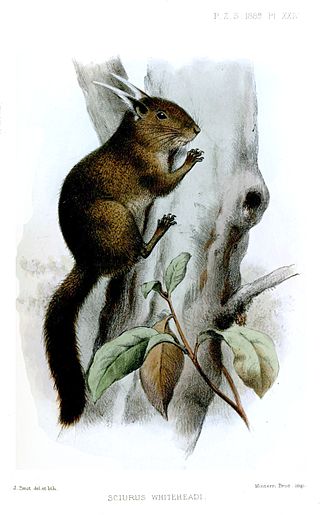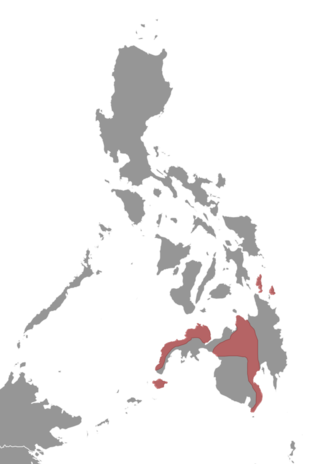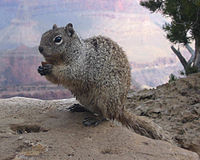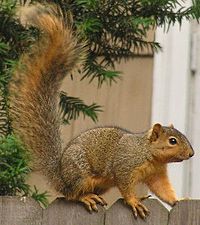
Flying squirrels are a tribe of 50 species of squirrels in the family Sciuridae. Despite their name, they are not in fact capable of full flight in the same way as birds or bats, but they are able to glide from one tree to another with the aid of a patagium, a furred skin membrane that stretches from wrist to ankle. Their long tails also provide stability as they glide. Anatomically they are very similar to other squirrels with a number of adaptations to suit their lifestyle; their limb bones are longer and their hand bones, foot bones, and distal vertebrae are shorter. Flying squirrels are able to steer and exert control over their glide path with their limbs and tail.

Sciurinae is a subfamily of squirrels, uniting the flying squirrels with certain related tree squirrels. Older sources place the flying squirrels in a separate subfamily (Pteromyinae) and unite all remaining sciurids into the subfamily Sciurinae, but this has been strongly refuted by genetic studies.
Thomas's flying squirrel is a species of rodent in the family Sciuridae. It is one of two species in the genus Aeromys. It is found in Indonesia and Malaysia.

The ear-spot squirrel is a species of rodent in the family Sciuridae. It is endemic to Borneo and is diurnal and active mainly in small trees. It closely resembles the plantain squirrel, but is smaller and with a distinct pale buffy patch behind each ear.

Phayre's squirrel is a species of rodent in the family Sciuridae. It is found in forests in China and Myanmar.

The Asian red-cheeked squirrel is a species of rodent in the family Sciuridae. It is found in south-eastern Asia.

The tufted pygmy squirrel is a species of rodent in the family Sciuridae. It is endemic to highland forest in Borneo. The common name of this tiny squirrel refers to its distinctive ear-tufts. Its diet consists mainly of the lichens and mosses which cover the trees it inhabits.
The montane long-nosed squirrel is a species of rodent in the family Sciuridae. It is endemic to central Sulawesi, Indonesia. Its natural habitat is subtropical or tropical dry lowland grassland. It was discovered during a 1930 expedition led by Gerd Heinrich.

The Basilan flying squirrel is a species of rodent in the family Sciuridae. It is endemic to the Philippines. It is often confused with the mindanao flying squirrel.

Petinomys is a genus of flying squirrels. They are known commonly as the dwarf flying squirrels.

The whiskered flying squirrel is a species of flying squirrel. It is found in Indonesia and Malaysia.
The Siberut flying squirrel is a species of rodent in the family Sciuridae. It is endemic to Indonesia. Its natural habitat is subtropical or tropical dry forests. It is threatened by habitat loss.

Temminck's flying squirrel is a species of rodent in the family Sciuridae. It is found in Indonesia, Malaysia, Myanmar, and Thailand.
Vordermann's flying squirrel is a species of rodent in the family Sciuridae. It is found in Indonesia, Malaysia, and Myanmar. It was described in 1890 by the Dutch zoologist Fredericus Anna Jentink, who named it after its discoverer, the Dutch physician Adolphe Vorderman.

The shrew-faced squirrel, also known as the long-nosed squirrel, is a species of rodent in the family Sciuridae. It is monotypic within the genus Rhinosciurus. It is found in forests in Peninsular Malaysia, Singapore, Sumatra and Borneo. This peculiar, terrestrial squirrel mainly feeds on insects and earthworms. It quite closely resembles a Tupaia treeshrew in appearance, but the shrew-faced squirrel can be recognized by its shorter gape, and shorter and more bushy tail.
Brooke's squirrel is a species of rodent in the family Sciuridae. It is found in Indonesia and Malaysia. Its natural habitat is subtropical or tropical dry forests. It is threatened by habitat loss. It was named for Charles Brooke, the second White Rajah of Sarawak by Oldfield Thomas from a specimen collected by Charles Hose on Mt Dulit.
Jentink's squirrel is a species of rodent in the family Sciuridae. It is named in honor of the Dutch zoologist Fredericus Anna Jentink. It is found in Indonesia and Malaysia. Its natural habitat is subtropical or tropical dry forests. It is threatened by habitat loss.

The Mindanao squirrel is a species of rodent in the family Sciuridae. It is endemic to the Philippines.

The Philippine tree squirrel is a species of rodent in the family Sciuridae which is endemic to the Philippines.
Kloss's squirrel or Kloss squirrel is a species of rodent in the family Sciuridae. It is endemic to northern Sumatra in Indonesia. Population data is insufficient to assess its conservation status according to the IUCN. It is sometimes considered a subspecies of C. notatus.















